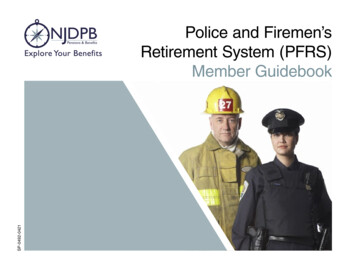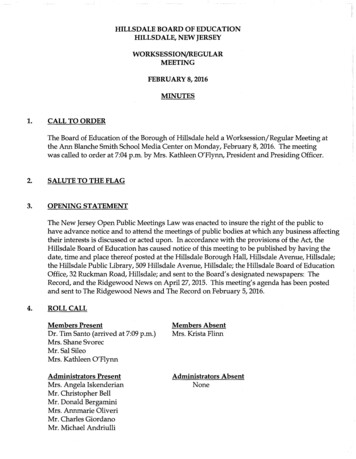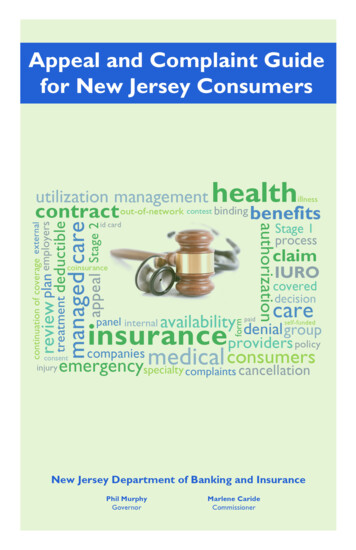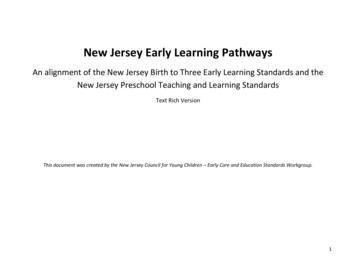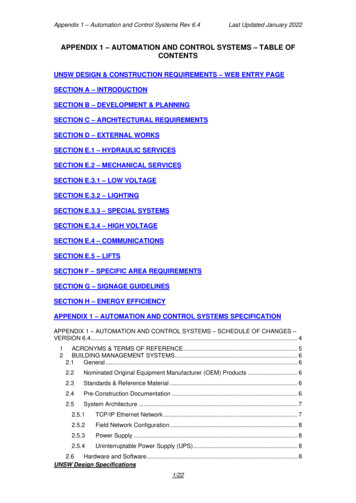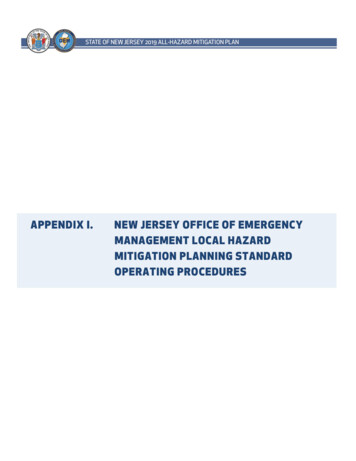
Transcription
APPENDIX I.NEW JERSEY OFFICE OF EMERGENCYMANAGEMENT LOCAL HAZARDMITIGATION PLANNING STANDARDOPERATING PROCEDURES
NEW JERSEY OFFICE: OF EMERGENCY MANAGEMENTHAZARD MITIGATION PLANNINGSTANDARD OPERATING PROCEDURE’SI-1
Purpose: To establish policy and procedures for the most efficient operation of the New Jersey Officeof Emergency Management Hazard Mitigation Planning Section.Hazard Mitigation PlanningThe Hazard Mitigation Planning process is the first step in supporting the mission of mitigation. Thepurpose of hazard mitigation planning is to identify policies and actions that can be implemented longterm to reduce risk and future losses. Hazard Mitigation Plans form the foundation for a community'slong-term strategy to reduce disaster losses and break the cycle of disaster damage, reconstruction, andrepetitive damages. The planning process is as important as the plan itself. It creates a framework forrisk-based decision making to reduce damages to lives, property, and the economy from futuredisasters. More importantly, it is meant to be an open process by which the community is activelyinvolved in the development of their hazard mitigation plan. Community participation is a vitalcomponent of this process.State and Local governments benefit from Mitigation Planning by: Identifying cost effective actions for risk reduction that are agreed uponby stakeholders and the publicFocusing resources on the greatest risks and vulnerabilitiesBuilding partnerships by involving people, organizations, and businessesIncreasing education and awareness of hazards and riskCommunicating priorities to state and federal officialsAligning risk reduction with other community objectivesProceduresIn an effort to facilitate the Hazard Mitigation Planning process, the New Jersey Office of EmergencyManagement will adhere to the following procedures:Plans Received - Local governments will submit all FEMA funded County hazard mitigation plans tothe NJOEM Hazard Mitigation Planning section for review. Once plans have been submitted toNJOEM, they will be entered into a spreadsheet that captures the name of plan, date received, stageof development, who reviewed the plan, and date the review was completed. Plans may be submittedin the following stages of development: Preliminary Hazard Mitigation Plan – must include hazard identification,risk assessment and mitigation strategy. It is being submitted as it beingdeveloped to ensure the local government is adhering to the regulations asstipulated by 44 CFR 201.6 and is actually on track to becoming approvablepending adoption and subsequent approval status. Draft Plan – plan is complete, but has not been adopted yet. Final Plan – plan is complete, with all resolutions and ready for final review.Plan will not be adopted until final FEMA approval.I-2
Documentation – It is necessary to document the “life” of the project from application to closeout.This will assist in any potential auditing situations.Filing System - All of the information will be documented in each plan’s file. The filing system willinclude, but will not be limited to the following documents: all correspondence (letters and pertinentemails), financial information, sub-grantee agreements, and closeout information.Letters - Various letters will be created and disseminated according to the activity in an effort todocument the review and approval process. The letters are as follows: Submittal letter for planning grant application to FEMATransmittal letterso Preliminary Hazard Mitigation Plano Plan Updateo Electronic Transmissions of the Hazard Mitigation Plan through physicalflash drives or internet-based transmittals, along with Adoption ResolutionsExtension request letterNJOEM Extension approval letterEnd of period of performance letterAPA (approvable pending adoption) letter for Hazard Mitigation PlanAPP (approved) letter for Hazard Mitigation PlanAPP (approved) letter for additional jurisdictionsAPA (approvable pending adoption) letter for jurisdictions that have not adoptedFinal FEMA ApprovalCloseout proceduresHazard Mitigation Plan Deliverables will include the following: Preliminary Plan deliverable will be reviewed by NJOEM and FEMA Region II and willinclude:o Letter of Transmittal;o Two (2) individual flash drives containing electronic copies of the Hazard MitigationPlan, including at a minimum the hazard identification/risk assessment and mitigationstrategy sections of the plan. Each Flash drive shall contain copies of the plan in aPortable Document Format (PDF) format and Microsoft Word (DOCX) format. Draft Plan deliverable will be reviewed by NJOEM and FEMA Region II and will include:o Letter of Transmittal;o Two (2) individual flash drives containing electronic copies of the Hazard MitigationPlan, including a complete hazard mitigation plan. Each Flash drive shall containcopies of the plan in a Portable Document Format (PDF) format and Microsoft Word(DOCX) format. This deliverable will incorporate review comments from thePreliminary Plan deliverable and will conform to all requirements of 44CFR Part201.6 with the exception of resolution(s) of adoption. Final Plan deliverable will include the following:o Letter of Transmittal;o Two (2) individual flash drives containing electronic copies of the Hazard MitigationI-3
Plan, including an entire adopted and approved hazard mitigation plan. Each Flashdrive shall contain copies of the plan in a Portable Document Format (PDF) formatand Microsoft Word (DOCX) format.In an effort to receive official approval of a Hazard Mitigation Plan, all items outlined in the FinalPlan deliverable must be submitted. All counties and municipalities are required, per the 44 CFR201.6, to officially adopt the Hazard Mitigation Plan in order to receive official approval andqualify for the following FEMA funding: HMA Programso HMGP (Hazard Mitigation Grant Program)o FMA (Flood Mitigation Assistance)o PDM (Pre Disaster Mitigation)NJOEM State Hazard Mitigation Planners/Community PlannersAll of the activities mentioned heretofore will be facilitated by NJOEM State Hazard MitigationPlanners or Community Planners. Typical duties are as follows: Review local mitigation plans for compliance with regulations, policies, and guidanceProvide written recommendations to local governments for plan improvementsUnder the direction of the Team Lead or Senior Planner, provide technical assistance to localand State officials on the preparation, revision, or updating of mitigation plans to complywith Federal requirements Tracks assigned plans through all elements of the review process, including data entry, anddrafting of crosswalk review, submittal letters, and approval letters, etc. Participates in team review sessions and coordinates closely with local contacts Provide planning related training to the other pertinent areas of the State as well as localgovernments. Working knowledge of pertinent laws, regulations, policies, and precedents that affect theuse of program and related support resources in the State. Ensure that there is a comprehensive knowledge of the major issues, program goals andobjectives, work processes, and administrative operations of the organization. Basic knowledge of the NFIP being that there has been an inclusion of those elements in thePlanning Guidance.Briefings and MeetingsAs part of their duties, State Hazard Mitigation Planners/Community Planners will travel to thecounty to explain the specifics of the Hazard Mitigation Planning Process funded through theHazard Mitigation Grant Program and Pre-Disaster Mitigation Programs – Federal programmaticrequirements, local, state, and Federal reporting responsibilities, financial requirements, andprocurement requirements.Additionally, State Hazard Mitigation Planners/Community Planners will attend meetings (whenavailable) to ensure locals are implementing the components of the grant to the specifications ofFederal requirements and State guidelines.I-4
I-5
PUBLIC NOTICE[Name] County Hazard Mitigation Planning Grant[Name] County has been approved for the Hazard Mitigation Planning Grant through the State of NewJersey Office of Emergency Management (NJOEM). The [Name] County is seeking the services of aqualified consulting firm to create a Hazard Mitigation Plan.The procedures for selection of the firm will be in accordance with procurement requirements set forthby the State/Federal Governments. All responses received will be evaluated in accordance with theselection criteria and corresponding point system, which is further explained in the Request forQualifications Package. The package also identifies the scope of services to be performed by the chosenfirm.Interested parties are invited to secure a Request for Qualifications Package from Contact Person,Address, City, New Jersey Zip Code or by calling 000-000-0000 with your request or by emailing yourrequest to email address. The package is available beginning Date. The response to this request mustbe hand delivered or mailed to the Point of Contact at the address above in such a manner that it isreceived no later than Date.[Name] County is an Equal Opportunity Employer. We encourage all small and minority-ownedbusinesses to apply.I-6
Name of CountyRequest for Statements of Qualifications and Cost ProposalsImplementation of FEMA Hazard Mitigation Planning GrantCreate a Multi-Jurisdictional Hazard Mitigation PlanPROPOSAL PACKETINTRODUCTION:Name of County has secured a grant through the Hazard Mitigation Grant Program and is seeking aconsulting firm for implementation purposes. This grant provides for the creation of a Multijurisdictional Hazard Mitigation Plan for the Name of County and its corresponding jurisdictions.PART 1 – MANAGEMENT AND ADMINISTRATION:Name of County will negotiate a fixed price basis contract. The scope of services, which theconsultant must be prepared and qualified to provide, are as follows:Project Scope of WorkPlanning Process – documentation will identify: Who was involved as part of a Hazard Mitigation Planning Committee, the roles andresponsibilities of each committee member and how they contributed to the process. Opportunities for public participation; Opportunities for participation by other agencies, communities, interested parties, etc.; Document outreach to adjacent counties and communities to assure consistency in risk,vulnerability and HM planning; and, Integration of other related plans and documents.o Plan Update: The plan must identify all participating jurisdictions, new or continuing and, ifknown, jurisdictions that no longer participate in the plan. The plan shall describe the process used to review and analyze each section ofthe plan (i.e. Planning Process, Risk Assessment, Mitigation Strategy, and PlanMaintenance). If the planning team or committee concludes that some sections of the planwarrant an update and others did not, the team or committee must document theprocess used to make that determination. The plan maintenance section requires a description of how the community waskept involved during the plan maintenance process (44 CFR 201.6(c)(4)(iii)) overthe past five years. However, since this contributes to the planning process, thecommunity may elect to describe this within the planning process section of theplan. The plan must include an endorsement from each participating jurisdiction. Theendorsement must include, at a minimum, that the jurisdiction’s professionalI-7
staff (i.e., Engineer, Planner, Zoning/Code Officer, and Flood Plain Manger)have reviewed the plan and certify that the plan is consistent with the professionalduties of their offices.Risk Assessment – the risk assessment will include: Description of all natural hazards that can affect the assets of our county; Identification of the location, extent, previous occurrences, and probability of futureoccurrences for each of the identified hazards; Assessment of the vulnerability of assets and the potential impact of each hazard; and, Estimates of potential losses based on best available data and predictive models and therisk assessment should address both existing and future assets.o Plan Update: The local risk assessment shall, at a minimum, report risk in a consistent mannerwith the Standardized Risk Template identified in the New Jersey State HazardMitigation Plan (State HMP). Innovative methods to measuring risk andvulnerability are encouraged; however, the standardized risk template allows forequal comparison of risk across plans. Plan updates may reference scientific and technical information of hazardsidentified within the State HMP to make hazard profiles within jurisdictionalplans more concise. Jurisdictions are encouraged to focus on specific changeswithin the community that may have lessened or increased risk to the profiledhazards since the previous plan. The local risk assessment update shall address any newly identified hazards thathave been determined to pose a threat. The plan update shall continue to describe occurrences of hazards included in thepreviously approved plan, and discuss new occurrences of hazard events. Theupdated plan shall incorporate any new historical records, or hazard data relatedto profiling hazards. Any maps included in the updated plan, must be consistent with the updatedinformation. The vulnerability overview in the updated plan shall describe any changes,clarifications, or refinements to the summary described in the previouslyapproved plan. It shall continue to include, by type of hazard, a generaldescription of the types of structures affected by the hazard. All Local Mitigation Plans approved by FEMA must address repetitive lossstructures in the risk assessment by describing the types (residential, commercial,institutional, etc.) and estimate the numbers of repetitive loss properties locatedin identified flood hazard areas. If new hazards and risks have been identified in the multi-jurisdictional riskassessment, the information must be attributed to the appropriate jurisdiction(s)or to the whole planning area or whichever applies. Where vulnerability to previously identified hazards has changed, the plan mustincorporate this information into the updated multi-jurisdictional risk assessmentand it must be attributed to the appropriate jurisdiction(s) or to the wholeplanning area or whichever applies. If the previously approved plan identified that data deficiencies would beaddressed at a later time, then the resolved deficiencies shall be incorporated inI-8
the updated plan. If the data deficiencies have not been resolved, they must beaddressed along with an explanation of why they have not been resolved.Mitigation Strategy – will include: Developing mitigation goals and identifying appropriate mitigation actions based on theresults of the risk assessment; Actions that address the full range of identified hazards; Actions that address both existing and future assets; An implementation strategy that includes prioritization of mitigation actions includingconsideration of relative costs and benefits, identification of parties responsible forimplementation, funding mechanisms and timelines for implementation.o Plan Update: HMP plan must identify the completed, deleted, or deferred actions or activitiesfrom the previously approved plan as a benchmark for progress. If the mitigationactions or activities remain unchanged from the previously approved plan, theupdated plan shall include in its prioritization any new mitigation actionsidentified since the previous plan was approved or through the plan updateprocess. The plan update provides an opportunity for local jurisdictions to reconsider therange of specific actions. If the mitigation actions remain unchanged from theprevious plan, then the update should indicate why changes are not necessary. All Local Mitigation Plans must describe each jurisdiction’s participation in theNFIP and must identify, analyze, and prioritize actions related to continuedcompliance with the NFIP. Each participating jurisdiction shall have its own appendix to highlight anddetail the jurisdiction’s mitigation actions. Each participating jurisdiction must provide valid and specific mitigationaction(s) for Repetitive Loss and Severe Repetitive Loss properties within thejurisdiction.Plan Maintenance – will describe the process to be used after the plan is adopted and approvedto: Incorporate the goals and actions of the mitigation plan into other available mechanismsand/or plans for implementation, such as county and local land use plans and developmentordinances; Provide for continued public involvement; Monitor and evaluate the plan and its implementation; and The method and schedule for future required plan updates.o Plan Update: The jurisdiction updating the plan shall review and consider items included inFEMA’s and State’s review. If items are not addressed, then the jurisdictionshould provide an explanation. The updated plan shall include an executive summary of changes to the planI-9
and a crosswalk tool to track changes.As part of the planning process, the community reviews and analyzes thepreviously approved plan’s method and schedule for monitoring and updating theplan, such as strengths and weaknesses and what elements, if any, have changes.The updated plan must include the method and schedule that will be used overthe next five years to monitor, evaluate, and update the plan.The updated plan shall continue to describe how the mitigation strategy,including goals and objectives, and mitigation actions will be incorporated intoother planning mechanisms, such as county and local land use plans anddevelopment ordinances, and also indicate how information contained in theplan, including hazard identification and the risk assessment, will be integratedinto other planning mechanisms.Jurisdictions are encouraged to make updated plans available online for viewingor download.When the community prepares the plan update, the process used to keep thecommunity involved over the previous five years must be explained, but issuggested that it is captured in the planning process. However, the updated planshall describe the process used to solicit public involvement during the planmaintenance process over the next five years.Plan maintenance shall be discussed during at least one County Office ofEmergency Management Coordinator meeting per year and a summary submittedto NJOEM.Hazard Mitigation Plan Deliverables will include the following:Preliminary Plan deliverable will be reviewed by NJOEM and FEMA Region II and willinclude: Letter of Transmittal; Two (2) individual flash drives containing electronic copies of the Hazard MitigationPlan, including at a minimum the hazard identification/risk assessment and mitigationstrategy sections of the plan. Each Flash drive shall contain copies of the plan in aPortable Document Format (PDF) format and Microsoft Word (DOCX) format.Draft Plan deliverable will be reviewed by NJOEM and FEMA Region II and will include: Letter of Transmittal; Two (2) individual flash drives containing electronic copies of the Hazard MitigationPlan, including a complete hazard mitigation plan. Each Flash drive shall contain copiesof the plan in a Portable Document Format (PDF) format and Microsoft Word (DOCX)format. This deliverable will incorporate review comments from the Preliminary Plandeliverable and will conform to all requirements of 44CFR Part 201.6 with the exceptionof resolution(s) of adoption.Final Plan deliverable will include the following: Letter of Transmittal; Two (2) individual flash drives containing electronic copies of the Hazard MitigationPlan, including an entire adopted and approved hazard mitigation plan. Each Flash driveshall contain copies of the plan in a Portable Document Format (PDF) format andI-10
Microsoft Word (DOCX) format.PART 2 – PROPOSALS:Proposals will be accepted by the Name of County, in the Name of Location , Address, City,New Jersey Zip Code until 0:00 PM on Day, Month Date, Year.In order to be considered, proposals must be received prior to the time and date specified herein.The County reserves the right to reject any or all responses. All responses should be sealed and theoutside of the envelope marked: REQUEST FOR STATEMENTS OF QUALIFICATIONS ANDCOST PROPOSALS, Implementation of FEMA Hazard Mitigation Planning Grant Program, Creationof Name of County Hazard Mitigation Plan.Consultants should possess qualifications and expertise in the following areas: Hazard Mitigation Planning Hazard Mitigation Grant Program State of New Jersey Mitigation PrioritiesAll proposals will be scored and ranked with the highest rated firm being awarded a contract. Theproposal must include a (1) A detailed budget (2) brief history of the firm and a resume’ of each personin the firm who will be assigned to the project; (3) documentation of the responder being a “qualifiedthird party provider” or the responder must be in good standing with the Secretary of State; and (4) alist of projects and contact person name, address and telephone number for which the individual/firmhas completed similar projects. This list will be used for reference purposes.Two (2) copies of the proposal and required supplemental information should beprovided.PART 3 – SELECTION CRITERIA:All responses to the solicitation will be evaluated according to the following criteria andcorresponding point system. The proposal will be evaluated on the basis of written materials. Sufficientinformation must be included in the response to ensure that the correct numbers of points are assigned.Incomplete or incorrect information may result in a lower score.Experience/Knowledge withHazard Mitigation Planning and Hazard Mitigation Grant ProgramExperience/Knowledge in Civil Engineering and Cost EstimationHazard Mitigation ProjectsExperience/Knowledge in Benefit Cost AnalysisExperience/Knowledge in Environmental and Cultural Resource considerationsTotal points for required and optional considerations25 points25 points25 points25 points100 pointsI-11
PART 4 – EVALUATION OF PROPOSALS:It is the intent of the County to conduct a fair and impartial evaluation of proposals received inresponse to this RFQ. The purpose of this evaluation will be to select the most qualified Consultant.The evaluation will be conducted in the stages as follows:A.Selection of Responsive ProposalsThe purpose of this stage is to determine whether each proposal meets the specifications ofthis RFQ and is sufficiently responsive to the RFQ to permit a complete evaluation. Aresponsive proposal must comply with the instructions stated in this RFQ with regard tocontent, organization, number of copies and timely delivery.B.Evaluation of ProposalsDuring this stage, the Evaluation Team members will individually review each responsiveproposal, identifying areas requiring clarification and preliminary scoring the responses.Following these individual reviews, the Evaluation Team will meet to identify questionsrequiring clarifications, if any. The County will notify Proposers in writing if it hasquestions/issues requiring clarification. Proposers must respond in writing within a specifictime.C.Selection of Best Qualified ProposerAt the conclusion of the proposal evaluation, the best qualified Proposer will be identifiedby the Evaluation Team and notified that they have been selected.D.Recommendation of AwardThe Evaluation Team will document the results of the evaluation process and recommendthe award of a contract to the selected Consultant.E.Contract AwardThe County will provide a contract agreement to the selected Consultant. Once the contractagreement is signed and returned to the County, an official “Notice to Proceed” will beissued. The Consultant will have ten (10) working days to initiate work after the Notice toProceed is issued.I-12
Questions concerning this proposal should be addressed to:The Name of CountyName of LocationAddressCity, New Jersey ZipProposals may be either mailed or hand-delivered to:The Name of CountyName of LocationAddressCity, New Jersey ZipThe deadline for submission is Month Date, Year at 0:00 PM.Name of County OEMOEMCountyPUBLICATION DATES: Month Date, Year; Month Date, YearI-13
Contract for Professional ServicesContract#:This Contract is made as of theday of, 2013 by and between,county government located in the State of New Jersey, by and through its Board of Freeholders,hereinafter referred to as the (CLIENT) , and (name of business) doing business as an individual [ ], apartnership [ ], or a corporation [ ], authorized to do business in the State of New Jersey, hereinafterreferred to as the CONSULTANT, whose Federal ID or Social Security Number is.ARTICLE 1 – SERVICESThe CONSULTANTS responsibility under this Contract is to provide professional/consultation services inthe area of Hazard Mitigation Planning, as more specifically set forth in the Scope of Work detailed inExhibit “A”.(CLIENT)representative/liaison during the performance of this Contract shall be, whose contact number is.ARTICLE 2 – SCHEDULEThe CONSULTANT shall commence services on, 2013.Reports and other items shall be delivered or completed in accordance with the detailed schedule setforth in Exhibit “A”.Any order issued during the effective date of this contract, but not completed within that period, shall becompleted by the CONSULTANT within the time specified in the order. The Contract shall govern theCONSULTANT and (CLIENT) ’s rights and obligations with respect to the extent as it the order werecompleted during the contract’s performance period.ARTICLE 3 – PAYMENT TO CONSULTANTA. The total amount to be paid by the (CLIENT) under this Contract for services and minor materialsshall not exceed 250,000. The CONSULTANT will bill (CLIENT) in progress payments of 10% StartUp, 30% Upon Acceptance of First Draft, 30% upon acceptance of second draft and 30% upon Finalacceptance. Specifics of each payment are outlined in Exhibit “A”.B. Invoices received from the CONSULTANT pursuant to the Contract will be reviewed and approved bythe initiating (CLIENT) Department, indicating that services have been rendered in conformity withthe Contract and then will sent to the Finance Department for payment. Invoices must reference thiscontract number.C. Final Invoice: In order for both parties herein to close their books and records, the CONSULTANT willclearly state “final invoice” on the CONSULTANT’S final/last billing to the (CLIENT) . This certifies thatall services have been properly performed and all charges and costs have beenI-14
invoiced to the (CLIENT) . Since this account will be thereupon be closed, any and other furtherchanges if not properly included on this final invoice are waived by the CONSULTANT.ARTICLE 4 – TRUTH IN NEGOTIATION CERTIFICATESignature of this Contract by the CONSULTANT shall act as the execution of the truth-in negotiationcertificate certifying that the wage rates and costs used to determine the compensation provided for inthis Contract are accurate, complete and current as of the date of the Contract and no higher than thosecharged the CONSULTANT’S most favored customer for the same substantially similar service.The said rates and costs shall be adjusted to exclude any significant sums shoulddetermine that the rates and costs were increased due to inaccurate, incomplete or non-current wagerates or due to inaccurate representations of fees paid to outside consultants. shallexercise its rights under this “Certificate” within one year (1) following final payment.ARTICLE 5 – TERMINATIONA. Termination for Default:may, by written notice to the CONSULTANT, terminate this contractfor default in whole or in part (release orders, if applicable) if the CONSULTANT fails to:1. Provide products or services that comply with the specifications herein or fails to meet the(CLIENT) performance standards.2. Deliver the supplies or perform the services within the time specified in this contract orany extension.3. Make progress so as to endanger performance of this contract.4. Perform any of the other provisions of this contract.Prior to termination for default, (CLIENT) will provide adequate written notice to theCONSULTANT through the Purchasing Director, affording him/her the opportunity to sure thedeficiencies or to submit a specific plan to resolve the deficiencies within ten (10) days (or the periodspecified in the notice) after receipt of the notice. Failure to adequately cure the deficiency shall resultin termination action. Such termination may also result in suspension or debarment of theCONSULTANT in accordance with applicable Louisiana procurement statutes. The CONSULTANT andits sureties (if any) shall be liable for any damage to the (CLIENT) resulting from the CONSULTANT’Sdefault of the contract. This liability includes any increased costs incurred by the (CLIENT)incompleting contract performance.In the event of termination by the (CLIENT)for any cause, the (CLIENT) will have, in no event,any claim against the (CLIENT) for lost profits or compensation for lost opportunities.I-15
After a receipt of a Termination Notice and except as otherwise directed by (CLIENT) theCONSULTANT shall:A. Stop work on the date and to the extent specified.B. Terminate and settle all order and subcontracts relating to the performance of the terminatedwork.C. Transfer all work in progress, completed work, and other materials related to the terminatedwork as directed by the (CLIENT).D. Continue and complete all parts of that work that have not been terminated (if applicable).Neither CONSULTANT nor (CLIENT) shall be liable, not may cancel this contract for default, when delaysarise out of causes beyond the control of CONSULTANT or (CLIENT) . Such causes may include, but arenot restricted to acts of God, acts of (CLIENT) in sovereign capacity, fires, floods, lightning stri
MITIGATION PLANNING STANDARD OPERATING PROCEDURES. I-1 . NEW JERSEY OFFICE: OF EMERGENCY MANAGEMENT HAZARD MITIGATION PLANNING . STANDARD OPERATING PROCEDURE'S . I-2 . Purpose: To establish policy and procedures for the most efficient operation of the New Jersey . It is necessary to document the "life" of the project from application to .
